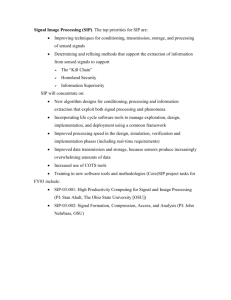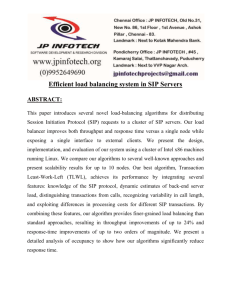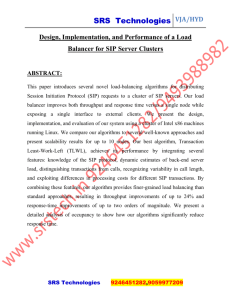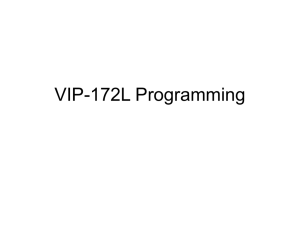Design, Implementation, and Performance of a
advertisement
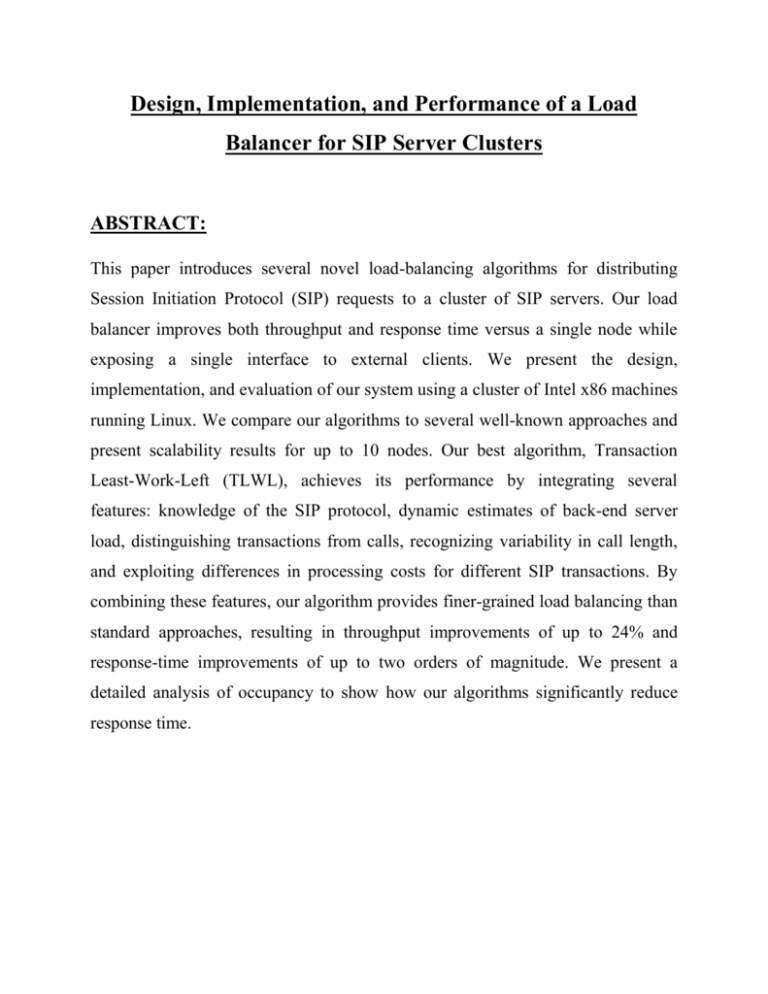
Design, Implementation, and Performance of a Load Balancer for SIP Server Clusters ABSTRACT: This paper introduces several novel load-balancing algorithms for distributing Session Initiation Protocol (SIP) requests to a cluster of SIP servers. Our load balancer improves both throughput and response time versus a single node while exposing a single interface to external clients. We present the design, implementation, and evaluation of our system using a cluster of Intel x86 machines running Linux. We compare our algorithms to several well-known approaches and present scalability results for up to 10 nodes. Our best algorithm, Transaction Least-Work-Left (TLWL), achieves its performance by integrating several features: knowledge of the SIP protocol, dynamic estimates of back-end server load, distinguishing transactions from calls, recognizing variability in call length, and exploiting differences in processing costs for different SIP transactions. By combining these features, our algorithm provides finer-grained load balancing than standard approaches, resulting in throughput improvements of up to 24% and response-time improvements of up to two orders of magnitude. We present a detailed analysis of occupancy to show how our algorithms significantly reduce response time. SYSTEM ARCHITECTURE: EXISTING SYSEM: THE SESSION Initiation Protocol (SIP) is a general-purpose signaling protocol used to control various types of media sessions. SIP is a protocol of growing importance, with uses in Voice over IP (VoIP), instant messaging, IPTV, voice conferencing, and video conferencing. Wireless providers are standardizing on SIP as the basis for the IP Multimedia System (IMS) standard for the Third Generation Partnership Project (3GPP). Third-party VoIP providers use SIP (e.g., Vonage, Gizmo), as do digital voice offerings from existing legacy telecommunications companies (telcos) (e.g., AT&T, Verizon) as well as their cable competitors (e.g., Comcast, Time-Warner). DISADVATNAGE OF EXISTING SYSTEM: PROPOSED SYSTEM: We introduce new algorithms that outperform existing ones. Our work is relevant not just to SIP, but also for other systems where it is advantageous for the load balancer to maintain sessions in which requests corresponding to the same session are sent by the load balancer to the same server. This paper makes the following contributions. • We introduce the novel load-balancing algorithms CJSQ, TJSQ, and TLWL, described above, and implement them in a working load balancer for SIP server clusters. Our load balancer is implemented in software in user space by extending the OpenSER SIP proxy. • We evaluate our algorithms in terms of throughput, response time, and scalability, comparing them to several standard “off-the-shelf” distribution policies such as round-robin or static hashing based on the SIP Call-ID. Our evaluation tests scalability up to 10 nodes. • We show that two of our new algorithms, TLWL and TJSQ, scale better, provide higher throughputs, and exhibit lower response times than any of the other approaches we tested. The differences in response times are particularly significant. For low to moderate workloads, TLWL and TJSQ provide response times for INVITE transactions that are an order of magnitude lower than that of any of the other approaches. Under high loads, the improvement increases to two orders of magnitude. ADAVANTAGES OF PROPOSED SYSTEM: These results show that our load balancer can effectively scale SIP server throughput and provide significantly lower response times without becoming a bottleneck. The dramatic response time reductions that we achieve with TLWL and TJSQ suggest that these algorithms should be adapted for other applications, particularly when response time is crucial. MODULES: MODULES DESCRIPTION: SYSTEM REQUIREMENTS: HARDWARE REQUIREMENTS: • System : Pentium IV 2.4 GHz. • Hard Disk : 40 GB. • Floppy Drive : 1.44 Mb. • Monitor : 15 VGA Colour. • Mouse : Logitech. • Ram : 512 Mb. SOFTWARE REQUIREMENTS: • Operating system : Windows XP. • Coding Language : JAVA • Front End : Swings • Back End : My SQL REFERENCE: Hongbo Jiang,Arun Iyengar, Erich Nahum, Wolfgang Segmuller Asser N. Tantawi, and Charles P.Wright, “Design, Implementation, and Performance of a Load Balancer for SIP Server Clusters”, IEEE/ACM TRANSACTIONS ON NETWORKING, 2012.




